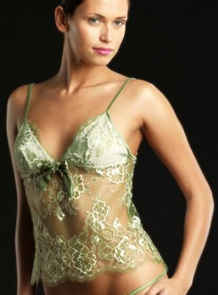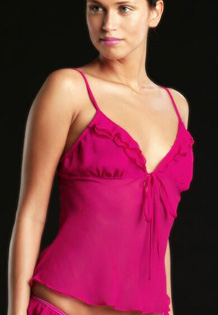| |
|
> > Sarees >> >>InnerGarments > >Accessories |
|
|
 |
-------When fashion and
desire are really matters CLICK Stretch Microfiber Bikini |
|
|
|
|
|
|
|
|
|
|
|
|
AN ASSESSMENT OF A DYNAMICALLY-INSULATED HEAT-PROTECTIVE
CLOTHING ASSEMBLY
G. W. CROCKFORD and M. A. AWAD EL KARIM
TUC Centenary Institute of Occupational Health, London School of
Hygiene and Tropical Medicine London WC1E 7HT, Department of Social and
Preventive Medicine, Faculty of Medicine, University of Khartoum Sudan
Experiments were conducted to evaluate the establishment of dynamic insulation
in an air-ventilated heat-protective clothing assembly. A model of the fabric
assembly used in the inner garment was also set up to enable a study to be made
of the dynamic insulation characteristics of the fabrics. The experiments with
the clothing assembly proved the establishment of dynamic insulation and these
findings were confirmed by the results of the model experiments. Modifications
made to the clothing assembly by sealing ankles and wrists and replacing the
original outer garment with a more permeable one, showed that the dynamic
insulation and the performance of the garment could be improved. Air flows in
excess of 25 cfm (0·82 m3/min) are required to operate the assembly effectively
in ambient temperatures of 50°C. The dynamic conductance values for the garment
were lower than those predicted by the dynamic insulation equation. for more
information click:
Annhyg.oxfordjournals.org
|
|
|
|
|
|
|
If you are in the great outdoors, sometimes the problem isn't just to stay dry
- you must be comfortable. So how is this achieved?
If you are in the great outdoors, sometimes the problem isn't
just to stay dry - you must be comfortable. So how is this achieved?
One of the greatest benchmarks of comfort when working or spending leisure time
in the outdoor world is the degree of dry warmth you experience. All people are
different in their warmth requirements - what may be okay for one person may be
far too cold or hot for another. The clothing needed to maintain a comfortable
average is happily readily available - but using it properly needs
understanding in order to be effective.
Let's say that you are a hiker or rambler. I use this example from experience
as I have been trudging around the UK countryside for years! However, the
'model' applies to whatever outdoor activity you take part in - hunting,
fishing, hiking or just being a spectator at an outdoor event. However, any
activity that requires varying physical effort - such as hiking - will produce
the widest 'discomfort band' of all.
The reason is simple. Whilst walking along flat, level ground the level of
effort remains fairly constant. Your body, a chemical engine, will convert its
reserves to provide you with the 'cruising level' of energy needed to maintain
this sustained, low-level effort. For this reason you will reach a median level
of energy expenditure, part of which is converted to heat - which is why you
become warm. As long as this effort remains constant, comfort is easily
achieved.
Now a steep hill looms. Your body goes into 'bottom gear' as you lift your body
weight against gravity to conquer the slope. The energy demands on your body
rise dramatically and far more heat is produced. If your body can't dissipate
that heat - you get hot. It's as simple as that.
Your body has one aim in mind: to keep your core temperature at a steady 98.6
degrees F. (37 degrees C.). It has two main methods of regulating this
temperature - perspiration to cool and shivering to warm. Either method can be
a cause of discomfort, so it seems logical that, if possible, you should aid
your body in its attempts to maintain a comfortable temperature. Now, unless
you sit still in a chair all day this ideal temperature will fluctuate. You're
not likely to notice much change much in everyday situations, but outdoor
activity is different. So how do you cope with the problem?
The answer is a principle called 'layering'. It works on the theory that
several thin layers are more flexible - in terms of temperature control - than
one thick layer. An ideal layering system would consist of a light, thin
'fleece' or insulating shirt (lower body garments can be added for colder
conditions), then a lightweight insulating and windproof jacket, then a
waterproof and 'breathable' outer shell garment. The inner garment is, in some
ways, the most important. When purchasing such a garment, ensure that it
possesses excellent 'wicking' properties - that is, it will transport
perspiration away from the skin effectively. This is essential. Perspiration
left on the skin can cause rapid chilling that can be very uncomfortable
indeed! The three-layer effect ensures that layers can be removed or added very
quickly in order to maintain a comfortable body temperature.
Layering garments are available from all good outdoor clothing stores and the
staff are generally knowledgeable - if they aren't, go elsewhere! Layering is
without doubt the finest way to maintain comfort in normal to cold conditions.
Real arctic conditions are beyond the scope of this article and specialist
advice should be sought if you're planning expeditions in these areas.
A last word about totally waterproof jackets. Yes, they will keep the water out
- which is not the same as keeping you dry, especially if, like myself, you
'run hot' when hiking. No jacket can change a physiological response - if the
humidity and water/air saturation outside the jacket exceeds the conditions
next to your body, you'll still get wet - but from your own perspiration!
Therefore, the more 'breathable' the jacket material the more comfortable you
will be - even if a little rain does get through!
In closing, I would advise anyone who plans to start outdoor activities to pay
attention to the clothing required - the method outlined above really can make
the difference between a pleasurable experience and one you would rather
forget!
Article Source: http://www.ArticlesAlley.com/
|
|
|
|
|
|
|
|
|
| |
 |
| Wedding Blog is not just about
marriages. It peeks into the various shades of human
relationship...it takes a closer look of the "what's-ins" and "what's-outs" of the wedding
fashion...et al. |
 |
| |
 |
| Click on
Top Wedlog Logo |
 |
| Click on
Top Wedlog Logo |
| |
 .gif) |
| |
|
|
 |
|